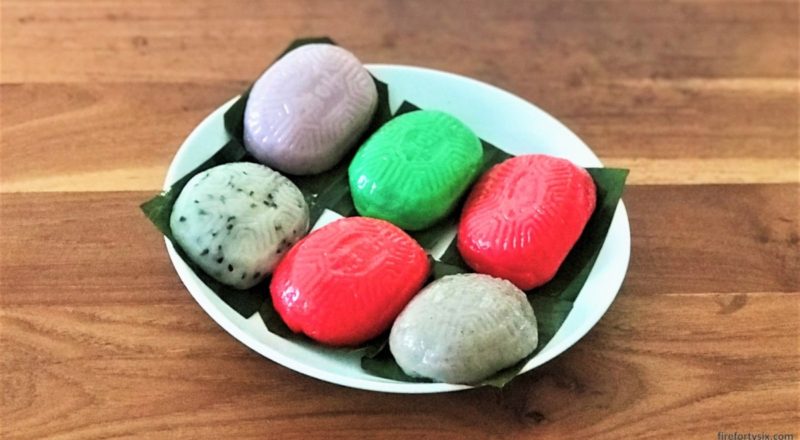Everton Park is an old school HDB estate in the Tanjong Pagar neighbourhood, one of the few remaining aging estates that still exist, as many across the island get demolished in the name of renewal. Over the years, it has gradually gentrified with new retailers and cafés moving in and setting up shop.

Ji Xiang Confectionery (吉祥食品) is not one of the new kids on the block. Well, perhaps it once was when it first opened in 1988, but it’s definitely not anymore. We happened to be in the area one Thursday afternoon and The Wife, being a big ang ku kueh (红龟粿) fan, decided to drop by and buy some for our breakfast the next day.
We underestimated their popularity and were quite surprised when we saw a crowd at their main counter. The queue started from there, continued across a few HDB pillars and stretched out beyond a dozen people.
There were numerous makeshift duct-tape arrows on the floor, spaced out at one metre intervals. The store staff policed these regularly, making sure that each customer stood on their own individual arrows, in order to comply with safe distancing regulations.


For those who aren’t familiar with ang ku kueh, a handwritten poster on the counter helpfully explains its origins and symbolism:
"Literally 'red turtle cake', ang ku kueh is a nonya (Straits Chinese) cake traditionally offered to gods and elders on certain religious festivals and occasions such as newborn's first month. Red is an auspicious colour for the Chinese, signifying luck & prosperity while a turtle, a creature with a very long lifespan, symbolises longevity... Ang ku kueh is made from glutinous rice flour and green bean paste filling. Each cake is then pressed into wooden molds with a turtle design and steamed. Today, it also comes with coconut and palm sugar filling, reflective of its Malay heritage..."

It was clear that business was brisk because two of the six flavours in their menu were already marked as sold out.
The Wife had originally planned to get one of each so that we could sample and compare across their entire range. Luckily, just as she reached the counter, they re-stocked the peanut flavour and even asked if she wanted to try the black sesame version, which was an off-menu item.


So, she ended up with six ang ku kueh, missing only the one with the corn filling. Well, technically it was only two ang ku kueh. Because ang (红) means red and four of them were coloured differently.


We started with the classic sweet green bean filling, and it was one of the better ang ku kueh that we’ve had. The skin was soft, chewy and not too thick, with the smooth green bean filling having just the right amount of sweetness.
The salted green bean filling with a grey-coloured skin, however, tasted really weird. It was definitely salty and not sweet, but it also seemed to contain black pepper. Not just a small pinch to provide an interesting flavour contrast, but quite a significant dose.
It was like having bites of mashed potato seasoned heavily by a pepper lover. We didn’t like it at all, and wouldn’t buy it again.


The yam and peanut versions were much better, with the former having a fragrant yammy taste. The flavour was not overpowering and there were delightful bits of yam with every bite.
I was surprised at the peanut one, as the filling wasn’t the usual coarse ground peanut plus sugar version used to coat muah chee. Instead, it was very fine and dense, and almost felt like a piece of peanut candy was wrapped with glutinous rice flour and then steamed. The texture was a bit strange to me, but The Wife really liked it.


We were similarly divided on the coconut and black sesame versions, because I’m not a big fan of black sesame and The Wife doesn’t particularly enjoy sweet grated coconut. So we compromised, and instead of splitting each in half to share, we took two-thirds of the one we liked.
As expected, I really liked the coconut filing but not the black sesame, and vice-versa for The Wife. The green skin used for the coconut made sense, as it had the same colour scheme as kueh dadar, a similar-tasting Malay kueh which I love.
However, I thought that the black sesame should have used a charcoal-coloured skin, which would have made for an interesting and non-traditional look. But then again, this wasn’t on their regular menu and if/when they decide to formally offer it, they might decide to change the skin colour to something darker.
If anyone from Ji Xiang is reading this, perhaps it’s something for you to consider?


Of the six flavours, my clear favourite was the coconut, whereas The Wife was split between the sweet bean and the peanut. We’ll probably stick with just those three flavours the next time.
It’s good that traditional shops like Ji Xiang Confectionery are experimenting with different flavours and colours, instead of simply sticking with the classic tried-and-tested ones.
While some might think that this dilutes the original symbolism of the beloved ang ku kueh, these innovations do make it more attractive and relatable to the younger generation, who may otherwise just give it a miss totally.
Judging from the amount of business they’re getting at their Everton Park shop, even on a hot weekday afternoon, it’s clear that they’re on the right path.
